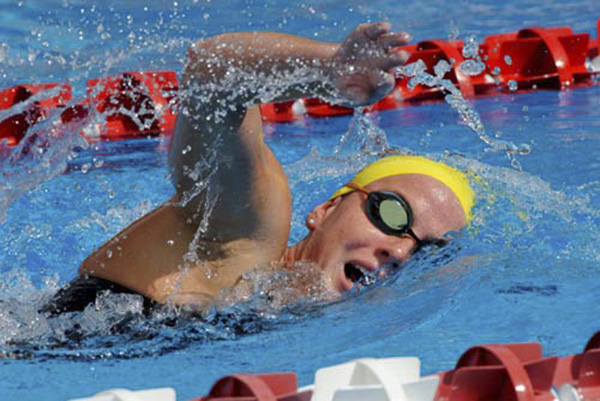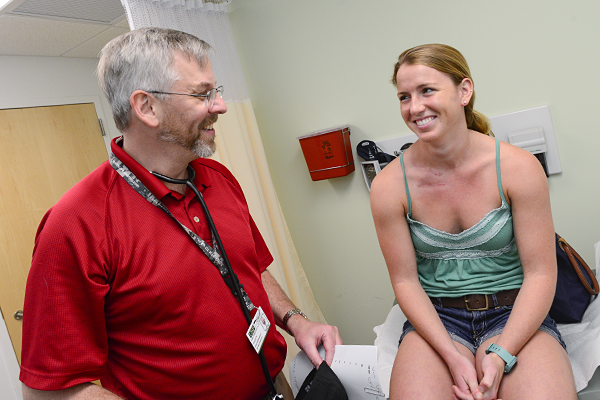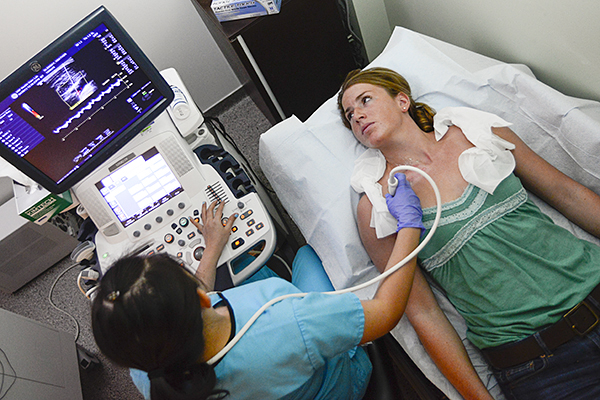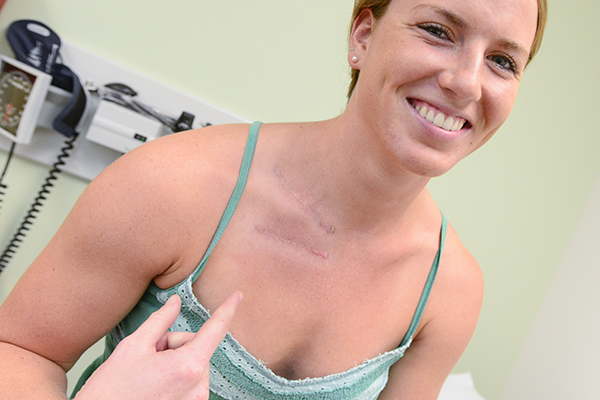]]>
Summer is synonymous with spending long, sun-drenched days playing or working outside. But that summertime fun can quickly turn into a dangerous health emergency if you aren’t prepared.
Heat advisories and excessive heat warnings are issued often in Florida and other hot spots around the country. According to the Environmental Protection Agency, extreme heat causes more than 1,300 U.S. deaths annually.
High temperatures may lead to heat-related illness, with heat stroke being the most serious. Exertional heatstroke occurs when a person’s body temperature rises above 105 degrees Fahrenheit and they can no longer naturally regulate their temperature.
“Exertional heat stroke usually starts with some sort of collapse,†said Rebecca Lopez, PhD, ATC, associate professor and program director of the post-professional athletic training programs in the USF Health Morsani College of Medicine’s School of Physical Therapy and Rehabilitation Sciences. “That is a main sign that something is wrong.â€
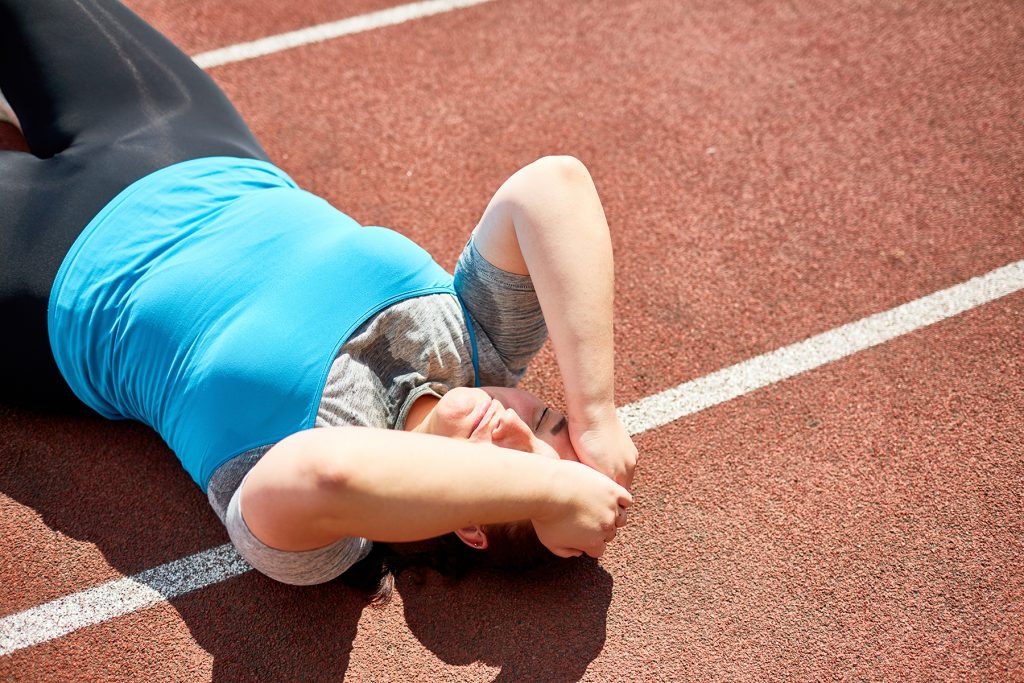
Heat stroke usually starts with a collapse.
Other symptoms include dizziness, shortness of breath, confusion and nausea.
High humidity—another common feature of Florida weather—can combine with hot temperatures to make a person even more susceptible to a heat stroke, Dr. Lopez said, noting,
“People don’t usually get exertional heat stroke just because it’s hot outside.â€
Your body regulates temperature by sweating, which produces a cooling effect by allowing the moisture to evaporate off the skin. High humidity, however, prevents the sweat from evaporating, so you only get hotter.
Dr. Lopez recommends, besides drinking plenty of water and taking regular breaks, that people spending time outside should “try to dress in light-weight clothing and keep some skin exposed to help that sweat evaporate.â€
Heat-related deaths and illnesses are preventable and treatable. During organized sporting activities, it’s important to have an athletic trainer available to identify and treat heat stroke and other heat-related illnesses.
For example, have a heavy-duty plastic tub or a tarp readily available that can be filled with ice-cold water to immerse most of the body to quickly reduce a heat stroke victim’s body temperature.
“The key to treating exertional heat stroke is to get (the victim’s) body temperature down as fast as possible†Dr. Lopez said.
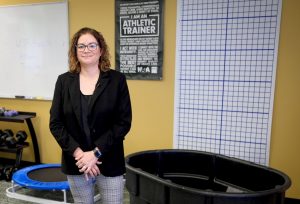
Rebecca Lopez, PhD, ATC
A key to being safe outside in the summer is acclimating to the heat. According to the Center for Disease Control and Prevention, heat acclimatization involves improving your heat tolerance by gradually increasing the intensity or duration of exercise performed in a hot setting. This usually takes one to two weeks. Many people don’t do this, which leads to problems.
“The summer is a really dangerous time with high school football teams and things of that nature,†Dr. Lopez said. “The first couple of summer practices are the most dangerous†because of the lack of heat acclimatization.
In the end, keeping summer days enjoyable requires care and planning.
“Avoid those hottest times of day, make sure you’re hydrated and ensure you are doing whatever you can to make sure you are in a healthy state to be out there in the heat.†Dr. Lopez said.
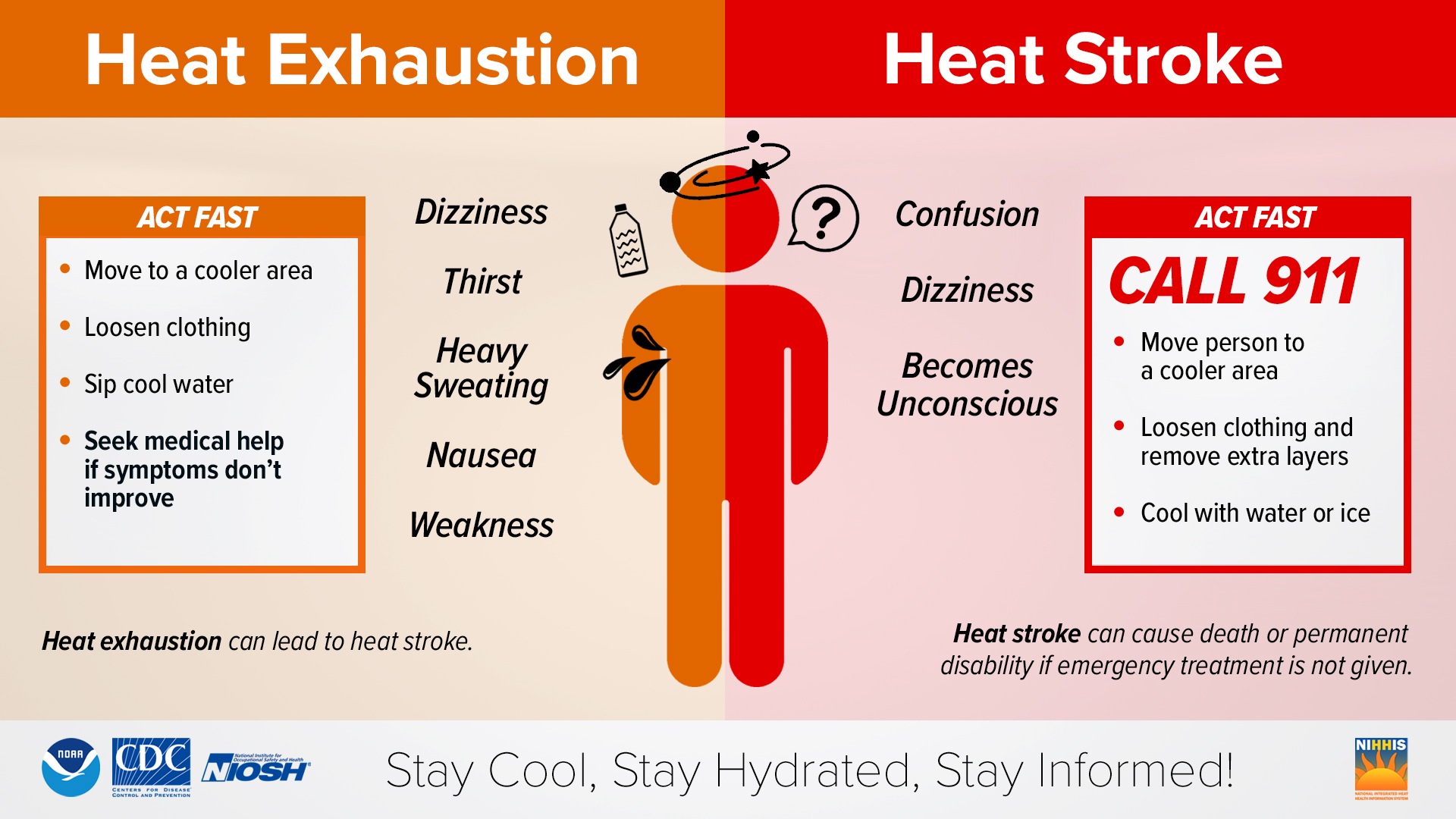
Videos & article by: Allison Long
]]>
]]>

USF Athletic Training Program student Amanda Roithmayr removes the hand tape from lineman Jean Marcellus at the conclusion of a preseason practice.
On July 15, USF Health and USF Athletics partnered on an implementation of an independent medical model that supports the physical and psychosocial welfare of student-athletes.
Under the new model, physicians will have increased contact with athletic trainers and student-athletes within the Selmon Athletic Center Athletic Training Clinic, where they care for more than 450 student-athletes.
The new model includes shifting reporting and funding lines of 16 athletic trainers and the Behavioral Health Coordinator previously in USF Athletics to now fall under the Department of Orthopedics and Sports Medicine within the USF Health Morsani College of Medicine, according to Jennifer Farrant, MSEd, ATC, administrator for the Department of Orthopedic Surgery and Sports Medicine and Department of USF Family Medicine.
“Through this model, we’ve found a way to make sure our athletic trainers are reporting through a physician to ensure the medical decisions made by and for the student-athlete are truly in his or her best interest,†Farrant said.
“Long-term, this model will increase the educational and research opportunities that come with having an athletic training program housed within a medical school,†Farrant added. “This new model will help the recruiting efforts of student-athletes, athletic trainers, and other primary care physicians.â€
Division 1 athletic trainers have historically reported through athletic departments and not a physician, Farrant noted.
In the past, physicians weren’t always available because they were in clinic or had other patient obligations, according to Renée Dubault, chief operating officer and associate executive director of Business Operations for USF Health.
“One of the most important benefits of this effort will be a better level of care for student-athletes and direct access to physician care,†Dubault said.
Models like this aren’t common, but there is a growing trend to move in this direction. The NCAA recommends true medical models with independent medical decision-making. Going forward, it’s important for athletic trainers and physicians to have that independence when it comes to medical decisions of student-athletes, said Steve Walz, MA, ATC, LAT, Associate Athletic Director-Director of Sports Medicine for USF Athletics. “It also allows for better collaboration and oversight of the athletic training staff with the team physicians.â€
“This will undoubtedly provide a greater breadth of care for our student-athletes,†Walz said. “With the increased contact and services with physicians and a better connection with USF Health, we have more tools to do what we need to do to keep student-athletes as healthy as possible. This will help continue to push the athletic training profession forward and help people realize it’s a medical profession with a lot of responsibility.â€
The NCAA hasn’t yet mandated the new model for all schools and sports programs. However, Walz said it isn’t about what is mandated, it is about providing the best healthcare system for the student-athlete. “We have been discussing this plan for several years now and in a large university environment it takes the right leadership so having people like Dr. (Charles) Lockwood, Michael Kelly, and Dr. (Roy) Sanders onboard for this is really how this finally came to fruition.â€
]]>
]]>
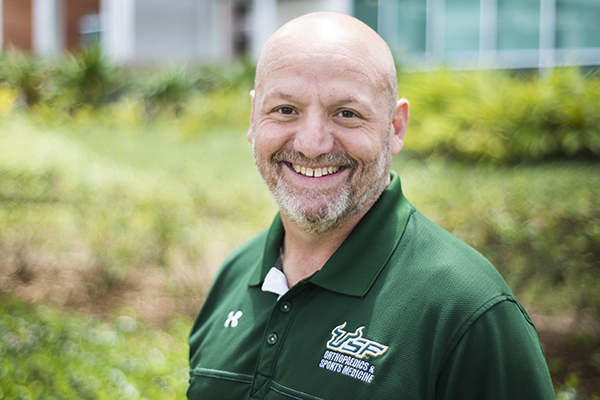
For the past 30 years, Steven Zinder, PhD, ATC, director of athletic training master’s program at the USF Health Morsani College of Medicine, focused his passion for science and sports into researching the biomechanics of the ankle. Dr. Zinder will be recognized as the 2017 Most Distinguished Athletic Director Trainer by the National Athletics Trainers Association in Houston this summer.
“I’m over-the-moon excited about receiving this award, and it’s humbling at the same time,†Dr. Zinder said.  “This isn’t a pat-on-your-back type of business. Twenty-eight years later I’m getting a pat on the back, and it feels pretty good.â€
Throughout his career, Dr. Zinder researched hundreds of ankle injuries to understand how they occurred and what could be done for prevention. In 2005, Dr. Zinder’s work led to a co-authored international patent on a device that assesses the stability of ankles in sitting and standing positions. Ankle injuries and stability are often evaluated while a patient is sitting, but the true way to assess the stability is when the patient is putting their full body weight on the ankle.
Before joining USF nearly five years ago, Dr. Zinder was a member of the athletic training education staff at the University of North Carolina in Chapel Hill. He has also worked with the Denver Broncos and taught at Bucknell University; the University of Virginia, where he earned his PhD; and California State University in Fullerton.
“What drew me to USF was the fact that the athletic training program was housed under the college of medicine,†Dr. Zinder said. “I had the job every athletic researcher wanted in North Carolina. Chapel Hill was the place to be and it took a special job to pull me away from there — USF was it.â€
Just two months after he arrived at USF, Dr. Zinder was promoted to direct MCOM’s Department of Athletic Training master’s program. It’s a position where he can mentor and lead the research of his faculty.
“Mentoring young faculty members with their research interests is much more enjoyable than pursuing my own,†he said.
Now in its third year, the USF athletic training master’s program is the standard for other colleges to emulate, Dr. Zinder said.  He takes extreme pride as one of only two such programs nationwide housed under the university’s medical school. This gives athletic training students the ability to work in interprofessional environments with students and faculty in other health colleges.
“Our program is shining very bright in the national spotlight,†Dr. Zinder said. “Other programs have looked at us to see how athletic training programs need to run. I’m always happy to help my contemporaries at other colleges because as an industry, we need to be better.â€
Story and Photo by Fredrick J. Coleman
]]>
]]>
When a subject line of an email reads “your patient Heather Glenday — Univ. of Tampa Swimmer†you pause.
Could this be sad news?
Luckily, it was wonderful news when Karl Illig, MD, professor of surgery and director of the USF Division of Vascular Surgery, opened such an email from his patient’s mother.
***
Photo by Andy Meng, UT
Last year, Heather Glenday, a swimmer for the University of Tampa, had a national title on the line when an odd feeling in her right arm slowed her training. A team trainer knew immediately by the swelling that the UT swimmer needed to get to the emergency room right away. At Tampa General Hospital, it was USF vascular surgeon Karl Illig, MD, who knew that Heather was experiencing Paget-Schroetter syndrome, a condition that causes a vein to be pinched off at the collarbone and upper rib. If left untreated, the vein could potentially clot off as the bone continues to crush the vein. For Heather, immediate surgery was necessary, which included removing that first rib.
Also called venous thoracic outlet syndrome (VTOS) and effort thrombosis, the uncommon condition affects only about 5,000 Americans every year, but is more common in high-performance athletes.
“It’s not unusual, and there is great success after treatment,†Dr. Illig said. “Surgery corrects the problem, with 95 percent of patients living a symptom-free life.â€
***
After her surgery last year, Heather spent her summer recuperating at home in New York.
“I’m incredibly lucky to have connected with Dr. Illig, who had already treated patients with this,†she said. “When I went for follow-up exams back home to check the incisions, the doctor there said ‘Oh, you’re the first patient I’ve seen with Paget-Schroetter’s,’ which wasn’t too comforting. I’m so lucky to have found Dr. Illig.â€
By fall, Heather returned to UT – she’s a junior studying accounting – and was back in the pool.
And that brings us back to Dr. Illig’s email.
Heather’s mother, Maureen Glenday, was sharing the good news with Dr. Illig that the young swimmer had not only recovered and returned to the pool, but that she was fast enough to help UT earn four NCAA trophies: two for relays and two for individual events.
Here’s what Maureen wrote to Dr. Illig in March.
***
Heather saw Dr. Illig’s this April at the Morsani Center for Advanced Healthcare for her one-year follow-up exam. The ultrasound showed all was well and he gave her a full release, although annual check-ups for the next couple of years are expected.
As a thank you, Heather presented Dr. Illig with a University of Tampa Spartans hat.
***
As if a story of a patient succeeding in life isn’t enough, another caveat is that Heather’s story ties together so many areas of expertise found in Tampa. It’s a story of a community of expert institutions coming together and providing the best care possible. Here are the players:
– University of Tampa has a title-winning swim team.
– Well trained athletic trainer recognizes symptoms and acts quickly to get the student to emergency room.
– Tampa General Hospital is affiliated with the USF Morsani College of Medicine, the region’s only academic medical center.
– Dr. Karl Illig has seen and treated this condition before in his training at academic medical centers.
***
To see Heather Glenday winning a 800 yard freestyle relay title for UT post-surgery, check out this video. Â Choose the 2013 DII Swimming & Diving Day 3, Evening Session: Full Replay (2:47:18) option and go to about 132/167.1.
Story by Sarah A. Worth, photos by Eric Younghans, USF Health Office of Communications
]]>
